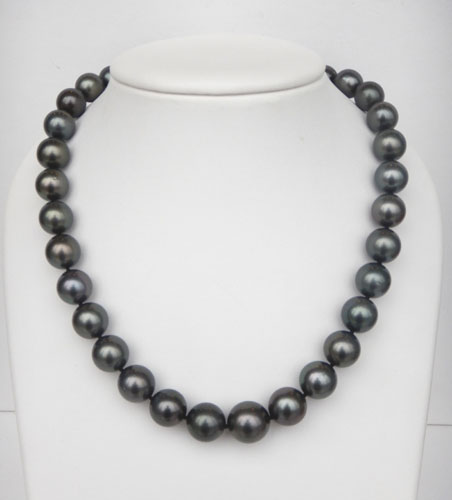Commonly known for their black color, Tahitian pearls are indigenous to the South Pacific region of French Polynesia. Second only in value to South Sea pearls, Tahitian pearls represent some of the most sought after pearls in the world. They are cultivated from the black-lipped variety of the pinctada maxima oyster and take many years to form.
During certain times of the year, the black-lipped pearl oyster produces offspring, known as “spat,” which are meticulously cared for by pearl farmers for three years until they are ready for grafting or nucleation (the process of inserting a small, round nucleus into the body of an oyster). The introduction of this foreign substance stimulates the secretion of a pearly substance called nacre, which is applied in layers by the oyster to the nucleus. After several years of nacre secretion over the nucleus, a pearl is formed. The pearl is then carefully removed and the oyster is put back into the lagoon. Of every 100 pearls nucleated, only 30 will produce a pearl. Out of those 30 pearls, only one or two will create a pearl suitable for fine jewelry.
Tahitian pearls come in a variety of different sizes, shapes, and colors. These pearls generally range in size anywhere from 8mm to 16mm and can be found in four basic shapes: round/semi round, semi-baroque, baroque, and circled. Their color can range anywhere from pale grey to anthracite black.
A Tahitian pearl’s quality is determined by its surface and luster. The pearls that are most valuable are large, round pearls that lack any visible flaws such as pits, bumps, scratches, deposits, ridges, and cracks. These precious pearls have very high luster, which means they’re extremely shiny and reflective. As a way to grade overall quality, Tahitian pearls can be defined by four basic qualities: A, B, C, and D.
- A quality pearls have very little to no flaws (less than 10%) and exhibit very high luster. These are the pearls you’ll see in our jewelry collection.
- B quality pearls exhibit high to medium luster and have flaws that are confined to less than one third of its surface.
- C quality pearls exhibit medium quality luster and have flaws distributed over more than one third of its surface.
- D quality pearls have flaws that cover more than two thirds of its surface.
If you have any questions regarding Tahitian pearls or any of the other pearl types, please call us at 414-276-2457 or email us at info@kloiberjewelers.com. Preview some of our Tahitian pearl jewelry collection here.


